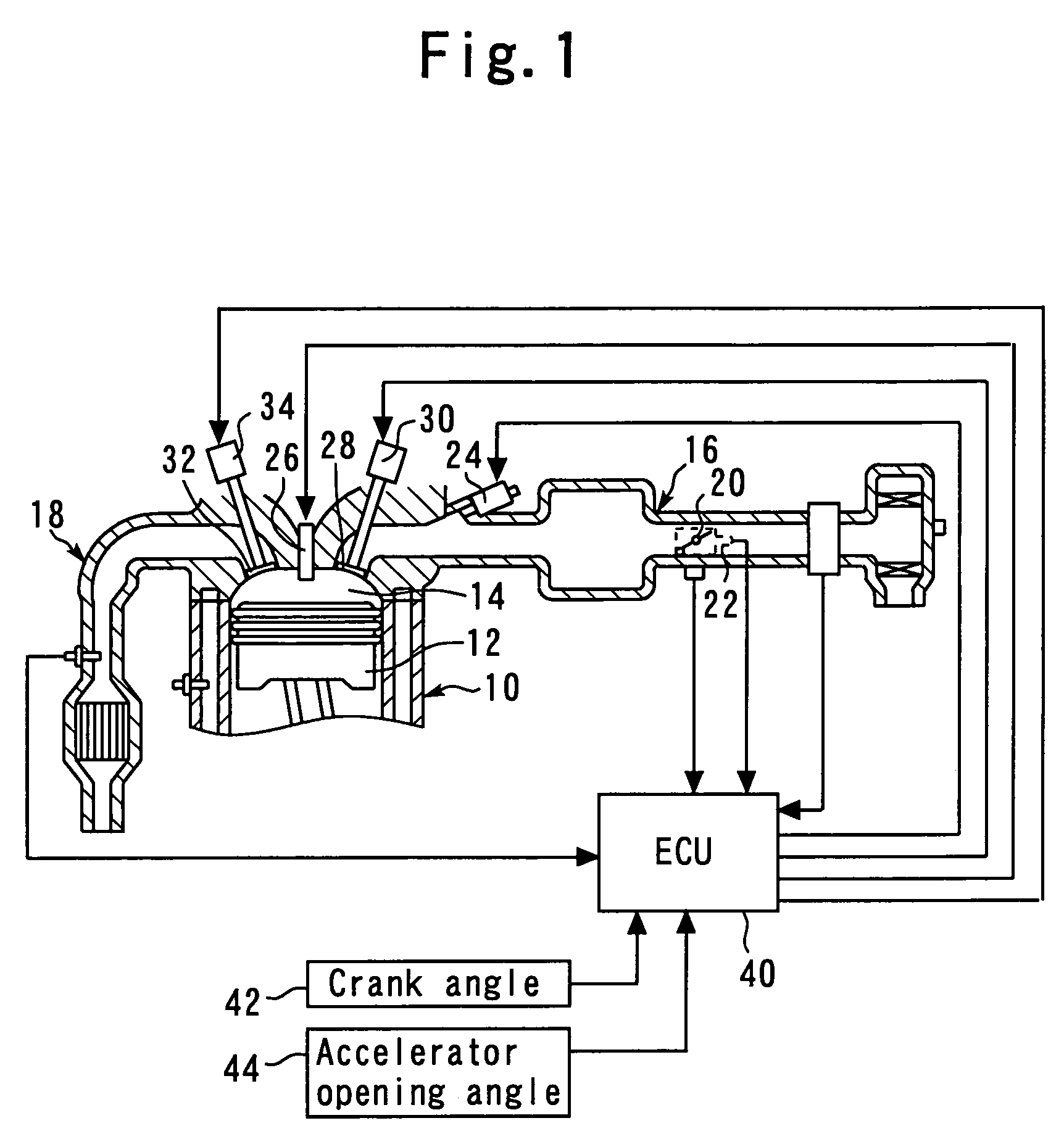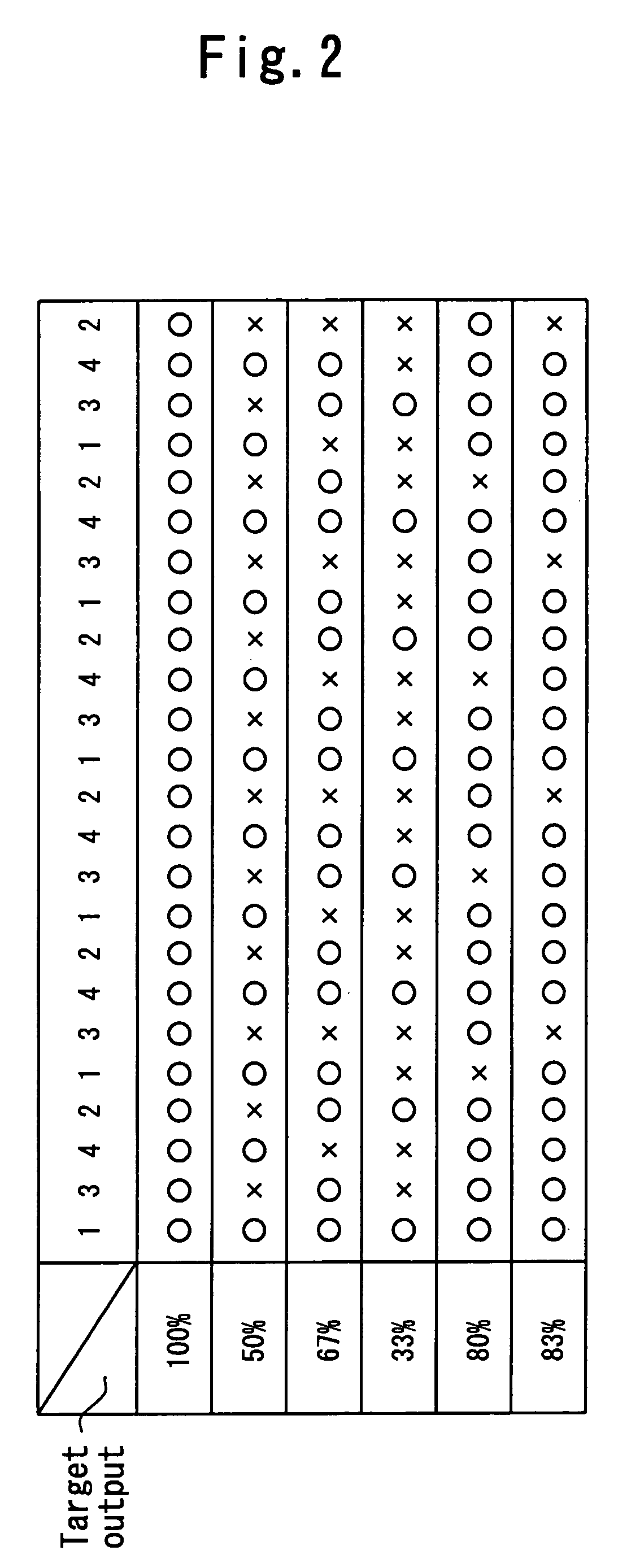Output control system for internal combustion engine
a technology of output control system and internal combustion engine, which is applied in electrical control, machines/engines, non-mechanical valves, etc., can solve the problems of difficult to conduct fine control of output, inability to fine control output using cylinder halts, and inability to control output for a smaller number of cylinders
- Summary
- Abstract
- Description
- Claims
- Application Information
AI Technical Summary
Benefits of technology
Problems solved by technology
Method used
Image
Examples
first embodiment
[0027]FIG. 1 is a diagram explaining a configuration of a first embodiment of the present invention.
[0028]The configuration shown in FIG. 1 includes an internal combustion engine 10. The internal combustion engine 10 has a piston 12 in a cylinder. The piston 12 can reciprocate inside the cylinder. Inside the cylinder of the internal combustion engine 10, a combustion chamber 14 is formed above the piston 12. Also, an intake air passageway 16 and an exhaust passageway 18 communicate with the combustion chamber 14.
[0029]A throttle valve 20 is provided in the intake air passageway 16. The throttle valve 20 is an electronic control throttle valve that can control a throttle angle TA independently of an accelerator-opening angle. A throttle sensor 22 that detects throttle angle TA is disposed near the throttle valve 20. A fuel injection valve 24 for injecting fuel into an air intake port of the internal combustion engine 10 is disposed on the downstream side of the throttle valve 20. An ...
second embodiment
[0057]Next, a second embodiment of the present invention is described below with reference to FIGS. 4 and 5.
[0058]A system of the present embodiment is realized according to the system configuration of the first embodiment.
[0059]In an internal combustion engine 10, the number of explosion strokes per unit time increases with an increase in engine speed. Accordingly, when combustion is halted, a combustion halt interval becomes shorter as the engine speed increases. In a high engine speed region, therefore, an increase in the number of combustion halts does not significantly affect drivability. For this reason, in the system of the present embodiment, a region in which output control is conducted only by cylinder halting is changed according to the particular operating state of the internal combustion engine.
[0060]FIG. 4 is a flowchart of the output control routine that the ECU 40 shown in FIG. 1 executes to realize the above function in the second embodiment. In FIG. 4, the same ref...
third embodiment
[0069]Next, a third embodiment of the present invention is described below with reference to FIGS. 6 to 8.
[0070]In a system of the present embodiment, output control based on the same control technique of the first embodiment (the routine of FIG. 3) is realized using the system configuration of the first embodiment.
[0071]The system of the present embodiment is characterized in that in a cylinder whose internal combustion is halted, any pump loss occurring in the halted cylinder is changed (controlled) by changing the valve timing used for that halted cylinder during a period of its internal combustion halt. According to the system of the present embodiment, changing any pump loss occurring in the halted cylinder makes it possible to alleviate any torque fluctuations and vibration occurring in an internal combustion engine 10 during the cylinder halt. Pump loss can also be prevented from occurring in the halted cylinder.
[0072]FIG. 6 is a timing chart showing an example of the valve t...
PUM
 Login to View More
Login to View More Abstract
Description
Claims
Application Information
 Login to View More
Login to View More - R&D
- Intellectual Property
- Life Sciences
- Materials
- Tech Scout
- Unparalleled Data Quality
- Higher Quality Content
- 60% Fewer Hallucinations
Browse by: Latest US Patents, China's latest patents, Technical Efficacy Thesaurus, Application Domain, Technology Topic, Popular Technical Reports.
© 2025 PatSnap. All rights reserved.Legal|Privacy policy|Modern Slavery Act Transparency Statement|Sitemap|About US| Contact US: help@patsnap.com



